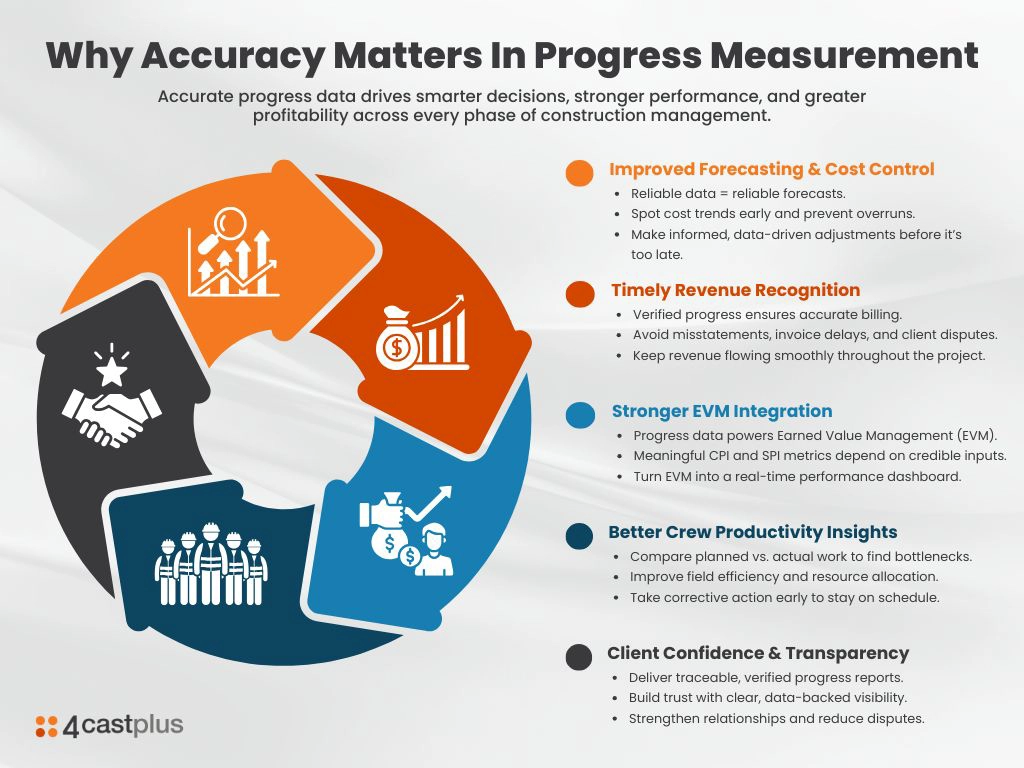Read In 10 Minutes
The Basics of Measuring Progress
We’re all measuring progress in normal life almost every day. To give you an example, if you’re two hours into a 4-hour drive, are you halfway there? You might be. But maybe there was bad traffic when you were leaving that added an extra half–hour onto your journey. To rely on time like this – i.e. how long you’ve been driving – as an indicator as to how far you’ve gone, is clearly not very accurate. Not surprisingly, a better method would be to use the actual distance traveled. If you take that distance and divide it by the total distance, you’ll get a percentage of completion of how far along you are in the journey. In this example, let’s say that after 2 hours, you’ve only made it 30% of the way. You’d know immediately that you’re clearly running behind, and it’s likely going to take you longer than 4 hours to get there.

This is the basics of measuring progress. You want to know how much of a task you’ve completed so that you can tell if you’re on track to finish on time and on budget. In our example above, you know fairly early on that you’re going to be late, so it gives you the opportunity to either make adjustments – like drive faster (not a good idea) – or to call your mom to let her know you’re going to be late for dinner. Either way, by measuring your progress early on in the journey, you have given yourself options.
Measure Project Progress – Enable Project Success
As in real life, progress measurements in construction projects enable timely decisions and help maintain control over complex operations. They form the foundation for reliable forecasting and earned value analysis, the metrics that separate proactive management from reactive crisis response.
Progress Measurements In Construction
Progress measurements in construction aren’t just a reporting exercise; they are a financial and operational imperative.
Regardless of the type of project, progress data drives almost every key management decision:
- Schedule performance – Identify delays before they cascade into major problems
- Earned value validation – Confirm you’re generating the expected value for costs incurred
- Productivity assessment – Evaluate crew and subcontractor efficiency objectively
- Cost forecasting – Project final costs based on actual completion rates
- Revenue recognition – Determine billable amounts based on verified completion
If your progress data is unreliable or inconsistent, every downstream calculation, from EVM to forecasts, is built on shaky ground. Inaccurate progress reporting can distort project visibility, lead to billing disputes, and mask early warning signs of overruns.
On the other hand, accurate and timely progress measurements deliver real-time project clarity, enabling teams to correct courses quickly and protect margins before small issues become financial crises.
Learn More About Timesheet Software
The Backbone of Performance Tracking
At its core, progress measurements answer one simple question: “How much work has been accomplished?”
But in construction, “work accomplished” can mean very different things depending on the scope, discipline, and the nature of what’s being measured. That’s why defining how you measure progress is just as important as measuring it.
It’s important to point out that you’re not actually measuring the project – you are in fact measuring the tasks within the project. A project may have hundreds or thousands of tasks of varying types and sizes and schedules. Since every task (or activity or workpackage) can be quite unique, there isn’t a one-size-fits-all solution for how to measure a project task. Most software solutions that help with progress measurements have multiple progress methods to choose from when deciding how to measure any particular task.
Common Progress Measurement Methods
- Units Completed – Ideal for repetitive, quantifiable activities (e.g., cubic meters of concrete poured, welds completed). Progress is based on physical quantities achieved versus total planned quantities.
- Hours Burned – Best for labor-intensive work where effort, not units, defines progress. The ratio of hours spent versus total planned hours indicates the percentage complete.
- Rules of Credit – Suited for complex activities broken into milestones or sub-steps, each assigned a weighted credit (e.g., engineering deliverables, design packages).
- Schedule, Based Progress – Aligns progress to schedule milestones or planned durations. Often used in conjunction with earned value reporting.
- Value of Work Done (VOWD) – Used on major capital projects to measure progress financially, tying percent complete to committed and spent costs.
Each method has its advantages, but the key is finding the right fit for each purpose. It also assumes that your project team is doing a thorough job of tracking the project. Tracking hours, and costs, and installed quantities, etc.
Why Accuracy Matters
Accurate progress measurements affect far more than just status updates. It underpins almost every core business process in construction project management.

1. Improved Forecasting and Cost Control
Accurate forecasting depends on knowing how much work is complete and how efficiently it was executed. Flawed progress data corrupts cost-to-complete calculations, creating either false confidence or unwarranted alarm.
Reliable progress measurements enable precise forecasting, reveal cost trends early, and support data-driven adjustments that protect budgets before overruns materialize.
2. Timely Revenue Recognition
For contractors working on fixed-price or long-term contracts, revenue recognition depends on verified progress. Accounting teams use progress percentages to determine how much revenue can be recognized each period.
Inaccurate progress data, whether lagging or overstated, creates accounting misstatements, delays invoicing, and triggers client disputes over billing accuracy.
3. Earned Value Management (EVM) Integration
Progress measurements are the foundation of Earned Value Management, the industry’s standard for performance tracking. The earned value of an activity equals its budgeted cost multiplied by its percent complete.
Without credible progress data, EVM metrics like Cost Performance Index (CPI) and Schedule Performance Index (SPI) are meaningless. When done right, however, progress measurement transforms EVM from a theoretical exercise into a real-time performance dashboard.
4. Crew Productivity and Operational Insight
At the field level, progress tracking helps supervisors evaluate crew performance, identify productivity bottlenecks, and optimize resource allocation.
By comparing planned versus actual output, teams can pinpoint inefficiencies, whether caused by labor issues, supply chain delays, or unforeseen conditions, and take corrective action before it impacts the schedule.
5. Client Confidence and Transparency
Clients want visibility. When you can present progress data that’s traceable, verified, and backed by quantitative metrics, you build trust. It shows professionalism, strengthens relationships, and reduces disputes over billing or scope.
The Cost of Inaccurate or Inconsistent Progress Data
When progress measurements are inconsistent, perhaps tracked manually, delayed, or based on subjective estimates, the ripple effects are wide-reaching:
- Forecasting errors: Misstated progress distorts future cost and completion predictions.
- Cash flow challenges: Late or inflated progress affects billing and cash management.
- EVM distortion: Performance indices lose meaning without reliable inputs.
- Decision delays: Management lacks confidence in data, slowing corrective action.
- Loss of credibility: Clients and stakeholders question project reporting integrity.
In short, unreliable progress measurements can quietly erode profitability, often without teams realizing it until too late.
How Modern Software Transforms Progress Measurements
Traditional progress tracking methods, spreadsheets, manual reports, and disjointed systems are error-prone and time-consuming. They require constant reconciliation between field data, cost systems, and schedules.
Modern project controls software like 4castplus centralize all of that into one cohesive environment, automating calculations, ensuring traceability, and enabling real-time visibility into progress across activities, disciplines, and contractors.
Key Advantages of an Integrated Platform
- Centralized Data Collection
Field teams, subcontractors, and engineers input progress directly into the system, reducing data lag and manual entry errors. - Configurable Measurement Methods
Each activity can be assigned the method best suited to its work type (units, hours, rules of credit, etc.), ensuring flexibility and consistency. - Automated EVM and Forecast Updates
As progress is entered, earned value, cost performance, and forecasts update automatically, eliminating duplication and human error. - Real-Time Dashboards
Visual dashboards present project health indicators instantly , giving managers deep project visibility all in one place. - Auditability and Traceability
Every data point is time-stamped and linked to source documentation, supporting internal reviews and client transparency.
With this kind of automation, progress measurement becomes less about chasing data and more about interpreting insights, empowering teams to act proactively rather than reactively.
The Strategic Value of Progress Measurements
Beyond the operational benefits, strong progress measurement practices deliver strategic advantages:
- Benchmarking and Continuous Improvement: Historical data helps establish productivity benchmarks and refine future estimates.
- Risk Mitigation: Early detection of slippage reduces risk exposure.
- Stakeholder Confidence: Transparent reporting enhances trust with clients, partners, and investors.
- Scalability: A standardized framework supports organizational growth across multiple projects.
In essence, progress measurements transform project controls from a reactive reporting function into a strategic performance management system.
Measure Better, Build Smarter
Progress measurements may seem like a technical detail, but in reality, it’s the heartbeat of every successful construction project. Without it, forecasting falters, costs drift, and profits shrink.
When teams commit to accurate, consistent, and automated progress tracking, they gain something far more valuable than data: clarity, confidence, and control.
Whether you manage small projects or massive industrial programs, investing in reliable progress measurement processes, supported by an integrated platform like 4castplus, is one of the smartest ways to ensure profitability, accountability, and long-term success.
Learn More
Want to see how 4castplus can help your teams work smarter together? From real-time field reporting to integrated cost control and streamlined change management, 4castplus connects every part of your project in one platform. Explore how our solution improves collaboration, boosts profitability, and gives you the visibility to keep projects on track—schedule a demo or learn more today.
 Platform
Platform Solutions
Solutions Owners
Owners Contractors
Contractors Engineering/EPCM
Engineering/EPCM Professional Services
Professional Services Resources
Resources White Papers
White Papers Case Studies
Case Studies Blog
Blog Videos
Videos Frequently Asked Questions
Frequently Asked Questions Company
Company About
About

